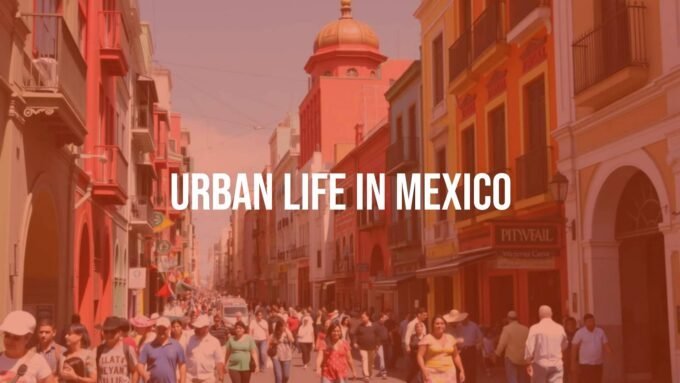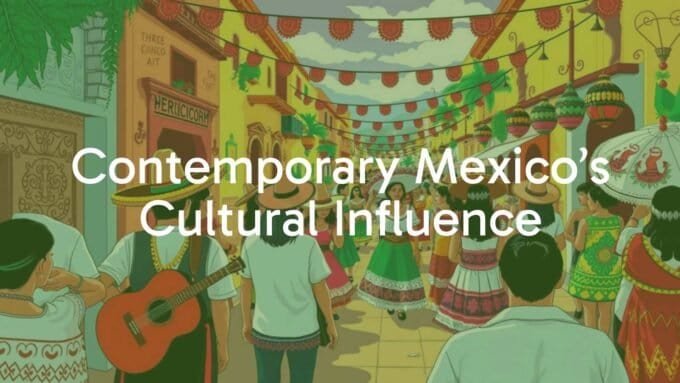Modern Mexican architecture is a lively mix of historical tradition, local character, and modern ideas. Architects in Mexico aim to create buildings for today and tomorrow, while respecting the country’s past. Their work results in spaces that are meaningful to Mexico but also appreciated around the world. Modern Mexican architecture is not just about putting up buildings; it’s about creating places people can enjoy, making use of local culture, and working with the unique Mexican climate and landscape. This type of architecture often uses bold color and dramatic sunlight and frequently connects outdoor and indoor spaces so they flow together. Modern Mexican design stands out for its special look and continues to change and influence new designs everywhere.

What Makes Modern Mexican Architecture Unique?
This style is a mix of many influences. Modern Mexican architecture is known for strong shapes, interesting materials, and a close relationship with its location and history. Its design often makes a statement simply through how it looks and feels.
Main Features and Design Traits
- Straightforward Shapes: Modern Mexican buildings usually have simple, straight lines and clear shapes, often using strong, local materials.
- Connection with Nature: Buildings are often placed to share views, courtyards, or gardens. Big windows and doors make indoor and outdoor spaces feel like one, leading to open, calming environments.
- Use of Color: Bright and bold colors stand out-an idea taken from Mexican art and the country’s bright sunlight.
- Texture: Concrete, wood, and stone are common, giving each space a strong sense of touch and personality.
- Light and Shadow: Architects pay careful attention to how the sun lights up areas indoors and outdoors. This creates strong visual effects and helps cool the space naturally.
- Water Features: Pools and fountains not only add beauty but also introduce calming sounds and coolness.

Main Influences
- Pre-Columbian Buildings: Ancient cultures contributed their ideas of grand scale, planning, and links to tradition.
- Spanish Colonial Styles: Spanish builders brought styles like Baroque and Neoclassical, leading to a blending of European and indigenous techniques.
- 20th Century Modernism: Movements like Bauhaus and the International Style entered Mexico, but local architects adapted these styles, keeping Mexican materials and traditions alive.
- Geography: The country’s many landscapes-mountains, coasts, deserts-influence design, leading to many local adaptations.
Modern vs. Traditional Mexican Architecture
| Traditional | Modern |
|---|---|
| Decorative fronts, strong and enclosed structures, inward focus with patios | Open and flowing spaces, simple shapes, strong indoor-outdoor connection |
| Limited openings for security/privacy | Large windows and open areas for light and views |
| Use of bright color but in small details | Color often used in large, bold areas |
| Mainly traditional materials | Use of new materials like reinforced concrete and steel, allowing for bold new forms |
What Historical Events Shaped Modern Mexican Architecture?
This type of architecture reflects the many changes in Mexican history. Major moments include:
Changes After the Revolution
- The Mexican Revolution (1910-1920) led to a focus on a national identity.
- Architects wanted to make buildings that felt truly Mexican, rather than copying European styles.
- Government-backed projects in housing, education, and health after the revolution helped this new style grow.
Notable early projects: José Villagrán García’s Institute of Hygiene.

International Modernism
- European and North American Modernism influenced Mexican architects in the 1900s.
- Materials like concrete and steel became popular, allowing for bigger, more daring buildings.
- Mexican architects blended these ideas with local styles, rather than copying them directly.
Example: Felix Candela’s thin-shell concrete churches.
Local and Indigenous Methods
- Even as new ideas arrived, traditional methods-like using adobe or stone-remained important, especially where they made sense for the local weather and environment.
- Local solutions, such as thermal mass for cooling, continue to influence design.
What Materials and Techniques Stand Out in Modern Mexican Architecture?
This style is known for a strong mix of materials and creative building methods.
Use of Concrete, Stone, and Color
- Concrete: Often left exposed, concrete gives a strong, simple, and permanent look.
- Stone: Local rock like cantera is popular and connects buildings to the land.
- Wood: Used for warmth and detail.
- Color: Architects like Luis Barragán use bright, traditional colors for dramatic effect.

Playing with Light and Shadow
- Careful planning of windows, courtyards, and pergolas helps direct sunlight where it is wanted, creating changing shadows and highlights.
- This approach brings out textures and helps keep spaces cool.
Merging Indoor and Outdoor Spaces
- Patios, gardens, and courtyards aren’t just add-ons – they’re central to how houses are used and enjoyed.
- Sliding doors and open passages connect inside and outside, making homes airy and bright.
Eco-Friendly and Sustainable Approaches
- Using local materials cuts down on shipping and is better for the environment (e.g., rammed earth in Casa Candelaria).
- Old ideas like natural ventilation and thick walls for cooling are combined with new technologies to save energy.
- Some recent projects even take inspiration from ancient farming methods (such as chinampas) for ecological design solutions.
Which Architects Are Leading Modern Mexican Architecture?
Many architects have shaped and are still shaping Mexican architecture. Key figures include:
Luis Barragán (1902-1988)
- Pritzker Prize winner, famous for combining light, color, and space in original ways.
- His houses (like Casa Luis Barragán and Cuadra San Cristóbal) use simple shapes, bright walls, gardens, and water to create tranquil and moving spaces.
Pedro Ramírez Vázquez (1919-2013)
- A major force behind public spaces, such as the Museo Nacional de Antropología.
- His work is known for large, simple forms and attention to how art and architecture work together.
Teodoro González de León (1926-2016)
- Famous for big, bold buildings in raw concrete – examples include the Museo Tamayo.
- He combines strength with careful landscaping and uses light to give his structures a sense of balance and openness.
Today’s Leading Architects
- Tatiana Bilbao (b. 1972): Designs homes and community projects that reflect the needs of real people, focusing on sustainability and social usefulness.
- Michel Rojkind (b. 1969): Known for creative forms and new materials, as in the wheel-shaped Circular Pictograma winery.
- Frida Escobedo (b. 1979): Mixes traditional materials with modern design to explore cultural identity, as in La Tallera gallery.

What Types of Buildings Show Modern Mexican Architecture Best?
Residential Buildings
- Modern homes often focus on large, open plans, the use of sunlight, and outdoor spaces as an important part of life.
- Examples include Luis Barragán’s colorful houses, Casa Tobi in Oaxaca, and Zacatitos 002 in Baja California Sur.
Cultural Buildings
- Museums, theaters, and community centers double as spaces for gathering and symbols of culture.
- Examples: Museo Nacional de Antropología and Museo Tamayo, along with newer community centers like PILARES in Mexico City.
Hotels, Restaurants, and Commercial Spaces
- Hotels and restaurants use local materials and design to create memorable experiences and connect with their environment, such as hotels in Cozumel or the Circular Pictograma winery.
Adaptive Reuse and Urban Renewal
- Turning old buildings into something new – updating Mexico City’s historic center or community projects like those by AMASA Estudio – helps cities grow wisely without losing their past.
What Are Some Notable Modern Mexican Buildings?
| Name | Location | Description |
|---|---|---|
| Casa Estudio Luis Barragán | Mexico City | Barragán’s own home and studio; known for colored walls, gardens, and creative use of light. |
| Cuadra San Cristóbal | Mexico City | An equestrian estate with bold colors, water features, and striking walls, soon opening to the public as a cultural site. |
| Museo Tamayo | Chapultepec Park, Mexico City | Large, angular concrete museum by González de León; stands out for its scale and how it fits into the park. |
| Museo Internacional del Barroco | Puebla | Designed by Toyo Ito, this modern white museum uses flowing forms to echo baroque style in a new way. |
| Conjunto Habitacional Nonoalco-Tlatelolco | Mexico City | A huge housing complex from the 1960s showing Modernist ideas in urban planning. |

How Does Modern Mexican Architecture Support Local Identity and Community?
Local Differences Across States
- Diverse climates and materials lead to a wide range of designs.
- For example, in Yucatán, buildings respond to the tropical climate, while in Baja California Sur, designs shield residents from desert heat.
Community-Focused Projects
- Post-revolution, many projects aimed to improve housing, education, and public health.
- Current projects like those by Colectivo C733 focus on improving life for community members, such as building schools and public spaces.
Showing Off Cultural Heritage
- Modern buildings often include colors, murals, and features inspired by Mexico’s past.
- This keeps both local craft and tradition alive in new work.
What Are Today’s Trends in Mexican Architecture?
Minimalism and New Layouts
- Designers focus on simple shapes and open spaces, letting materials, daylight, and volume play the main role.
- Example: Rubén Valdez Practice’s minimal, concrete ceremony space in Baja California.
Revival of Brutalist Ideas
- Heavy use of concrete and raw materials is still popular, often mixed with plants or wood for warmth.
Young and Innovative Designers
- Studios like Tatiana Bilbao’s and Rojkind Arquitectos try new ideas, materials, and work closely with communities.
Green and Strong Designs
- Many projects now focus on saving energy, using less water, and blending buildings with nature.
- Projects often use passive systems (like natural cooling), renewable energy, and eco-friendly building methods inspired by local wisdom.
FAQ: Modern Mexican Architecture
How Can I See Modern Architecture in Mexico?
- Visit key buildings like Casa Estudio Luis Barragán or the National Museum of Anthropology in Mexico City.
- Regions like Puebla or San Miguel de Allende offer more examples.
- Some private homes are featured in magazines and online, offering virtual tours.
- You can also stay in boutique hotels designed by famous architects, or join city architecture tours and open house events.
Why Is Modern Mexican Architecture Important?
- It combines global design with deep Mexican roots, creating a style that stands out worldwide.
- Mexican architects have led the way in eco-friendly and climate-smart design, teaching lessons that can apply anywhere.
- The focus on building community, especially through public and social projects, serves as a model for cities worldwide.
- These buildings blend beauty, tradition, social care, and smart use of resources.














Leave a comment